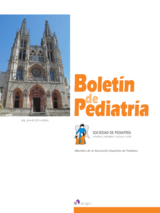Síndrome hemolítico-urémico: a propósito de dos casos
E. Ortega Vicente , B. Salamanca Zarzuela , M. Benito Gutiérrez , S. Puente Montes , M. Pino Velázquez
Bol. Pediatr. 2016; 56 (237): 178 - 181
Introducción. El síndrome hemolítico-urémico (SHU)se define por la tríada: anemia hemolítica microangiopática, trombopenia e insuficiencia renal aguda. Existen dos variantes: típico y atípico. El síndrome hemolítico-urémicoMtípico suele ser secundario a un proceso gastrointestinal principalmente diarrea mucosanguinolenta producida por E. coli enterotoxigénico y menos frecuentemente por Shigella dysenteriae y otras bacterias productoras de la toxina Shiga. El SHU típico supone el 90% de los casos en niños. La variante atípica (10% de los casos), no asocia diarrea y puede ser secundaria a infección invasiva por Streptococcus pneumoniae, a trastornos en la regulación del complemento de origen genético o a factores externos (fármacos, infecciones…). Tienen, en general, peor pronóstico y su menor frecuencia dificulta su reconocimiento. Casos clínicos. A continuación presentamos dos casos de SHU ocurridos en nuestra UCIP, uno atípico y otro típico en los que el diagnóstico, evolución y tratamiento fue notablemente diferente.
Hemolytic-uremic syndrome: two cases report
Introduction. Hemolytic-uremic syndrome (HUS) is defined by the triad of microangiopathic hemolytic anemia thrombocytopenia and acute renal failure. There are two variants: typical and atypical. The typical HUS is usually secondary to gastrointestinal mucosanguinolenta process mainly diarrhea caused by enterotoxigenic E. coli and Shigella dysenteriae less frequently, producing the Shiga toxin. The typical HUS accounts for 90% of cases in children. Atypical variant (10% of cases), not associated diarrhea and may be secondary to infection by Streptococcus pneumoniae invasive and disturbances in complement regulation genetic or external factors (drugs, infections ...). Generally they have worse prognosis and less often difficult to recognize. Clinical cases. Here are two cases of HUS occurring in our PICU, one atypical and other typical in the diagnosis, treatment and evolution was remarkably different.
Artículo completo (PDF) (71 kb.)
- Nefrourología
Buscar en el boletín
Año 2016, Volumen 56, Número 237

Boletín completo en PDF (655 kb.)